Imagine a mountain that has never seen the tread of human footsteps not by reason of it being too high like Everest but perhaps staid by an overwhelming regard for its sanctity. It is said that time itself behaves unusually; it is believed that 12 hours there equals the growth of hair and nails for two weeks. Welcome to Mount Kailash, a Himalayan peak that stands against all common conceptions as one of the mysterious natural wonders on Earth.
For centuries, the almost perfectly symmetrical pyramid-like structure of the mountain and its snow-clad summit have been regarded as an awe-inspiring object of reverence, with believers associating it with Lord Shiva in Hinduism, Demchok in Buddhism, Rishabhadeva in Jainism, and the spiritual abode of Tonpa Shenrab Miwoche, the founder of Bon tradition. Despite the difficult and remote setting of the mountain, the pilgrims tread difficult paths to circumambulate its base, believing that it cleanses them of their sins and bestows moksha.
Join us as we take a virtual tour of this incredibly unique peak. The blog uncovers a rich palette of beliefs and tales concerning Kailash from the abode of Lord Shiva to being an ancient land-mark in cosmic geography. Whether you are a spiritual seeker, a couch adventurer, or simply curious about one of the world's most enigmatic wonders of nature on earth, get ready to be amazed by the timeless mystery of Kailash Parvat.
Listen to Our Podcast: Mount Kailash
Mount Kailash Facts
Here are some facts related to Mount Kailash:
|
Site |
Mount Kailash |
|
Location |
Ngari Prefecture, Tibet |
|
Chinese Name |
Gang Rinpoche |
|
Major Deities |
|
|
Major River Originated |
|
|
Elevation |
6,638 meters |
|
Shape |
Pyramid |
|
Affiliation |
|
|
Nearby Attraction |
|
Mount Kailash Significance
Despite not being a very tall peak, Mount Kailash in the remote Himalayan region of Tibet holds great spiritual, religious, and cultural significance for many major religions. Thousands of pilgrims come every year to receive blessings, to be purified, and to be liberated.
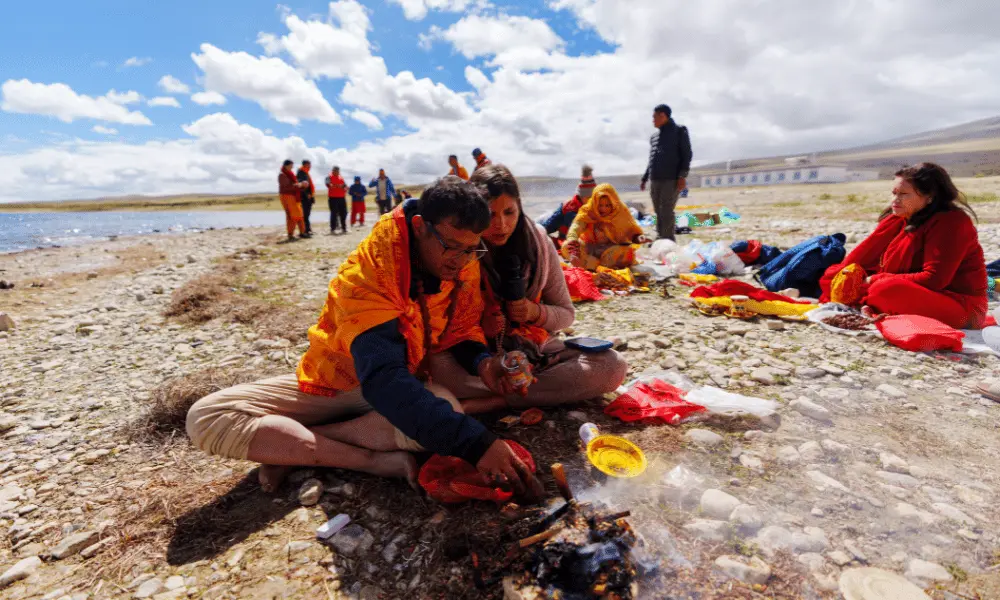
Religious Significance
Mount Kailash is probably the only mountain in the whole world considered sacred by four religions, Hinduism, Buddhism, Jainism, and Bon. Each of these traditions views the mountain from their own religious point of view. Here are the importances for each:
Hinduism
Being defined by immense spiritual significance, Hinduism places Mount Kailash as the abode of Lord Shiva, one of the major deities of Hinduism. Seen as the heart of the universe and a symbol of spiritual energy, the mountain is believed to be where Lord Shiva sits in eternal meditation with his consort Parvati. The pilgrimage to Kailash Parikrama is a hard one, undertaken by hope for spiritual merit and liberation (mukti). Despite its religious significance, the summit remains unclimbed biologically, rendering it a divine and untouchable entity in Hindu belief.
Buddhism
In Tibetan Buddhism, Mount Kailash is recognized as the abode of Demchok (Chakrasamvara), a god signifying ultimate bliss. It is equated with the mythical Mount Meru, which is postulated to be the central axis of the universe in Buddhist cosmology. Tibetan Buddhists perform a ritualistic pilgrimage termed kora, where they circumambulate the mountain clockwise, believing each round confers spiritual merit. Some believe that by finishing 108 samplings, one attains enlightenment. Therefore, Kailash is an occasion for revering spiritual power, cosmic unity, and sources of enlightenment.
Jainism
In Jainism, Mount Kailash is called Ashtapada and is believed to be the mount of liberation from the earthly realm for the first Tirthankara of Jainism, Rishabhadeva (Adinath). Jains do not engage in regular pilgrimages to the mountain, due to its distance and politically sensitive location, but it is very much alive in their spirituality as a symbol of ultimate release and spiritual fulfilment. It embodies the ideals of asceticism, meditation, and liberation that form the very core of Jain philosophy.
Bon Followers
According to Bon, the ancient pre-Buddhist religion of Tibet, Mount Kailash is called "Nine-Story Swastika Mountain." It is the abode of Shenrab Miwo, Bon's founder and the enlightened teacher. This sacred mountain is a pole of manifestation for the universe from whence the world unfolds. Bon practitioners perform counter-clockwise circumambulation around this mountain in the ocean for worship, as they believe their very act will cleanse their karma and allow them to align with the universal order.
General Significance
Apart from the above, here are some other significances of the mountain that make this giant special:
- Unclimbed Peak: Like many peaks in the Himalayas, Mount Kailash is a mountain awaiting its first climbers. And why is that so? It is respected for its grandeur position as a divine mountain, respected by the Chinese government.
- Mystic Energy: Many visitors report a strong and transformative energy in and around Kailash, giving it its reputation as a "spiritual energy vortex" and "link between Heaven and Earth."
- Lake Manasarovar: Lake Manasarovar, close to Kailash, is also held in the highest regard. In Hinduism, it is considered to be created in Lord Brahma's mind, and water from that lake is believed to erase sins after bathing.
- Unusual Geography: The unique pyramid shape of the mountain with its four distinguishable faces, each of which is thought in the Hindu texts to consist of a different jewel (crystal, ruby, gold, and lapis lazuli), further adds to its mystique. Some have even reported seeing a 'face of Lord Shiva' or the symbol of a Swastika on its face.
Where is Mount Kailash?
Mount Kailash, the summit of ultimate sanctity, is situated in the somewhat remote southwestern corner of the Nagri River Prefecture of the Tibet Autonomous Region of China. This majestic peak, lying near the sources of some of the mightiest rivers of Asia, becomes both a geographic and spiritual nexus. Mount Kailash is revered by followers of multiple faiths and is an amazing natural wonder of the world.
Geographical Features
Mount Kailash forms a part of the Kailash range located on the borders of the Trans-Himalayan region. The mountain is flanked by diverse geographical features comprising huge plateaus, towering peaks, and spreading river systems. It sits close to the sources of four important rivers, the Indus, Sutlej, Brahmaputra, and Karnali, thus asserting its importance in regional hydrology.
Altitude and Topography
Mount Kailash stands at an altitude of 6,638 meters. Different from other towering peaks in the region, the mountain is distinctively shaped in a symmetrical shape almost like a pyramid. It belongs to the Kailash Range, which is a facade of the greater Trans Himalaya. The topographic features include extreme vertical faces and deep valleys that make it both an awe-inspiring and difficult sight to behold.
Climatic Conditions
The climate around Mount Kailash is harsh and variable, with intense cold and strong winds. Winters are long and severe, with temperatures dropping far below the freezing point. Summers are short and cool, with temperatures sometimes going up to 15°C (59°F). This little gap between May and September, when weather is fairer and more cooperative, marks the best period to trek around Mount Kailash.
Wildlife and Vegetation
The Kailash region shelters many kinds of fauna, adapted to the area's considerably harsh climate and rough terrain. A full range of mammals of considerable adaptation to extreme conditions includes the snow leopard, blue sheep, tibetan antelopes, and wild yak. Birds such as the Tibetan snowcock, bearded vulture, and the Himalayan griffon vulture can find their homeland in high altitudes. Lake Manasarovar hosts cold-water fishes. Scanty vegetation allows hardy shrubs, grasses, and wildflowers to lure herbivores and promote local medicinal traditions.
Related Read: How to Reach Kailash Mansarovar?
Mount Kailash Features
Mount Kailash or the holy Kailash Parvat, is a physically imposing and geologically distinctive peak of the Trans Himalaya range in the Kailash Range of western Tibet, with an elevation of 6,638 meters above sea level. Different from many other tall Himalayan mountains, its single most striking physical attribute is that it is almost perfectly symmetrical, standing roughly as an equal-sided pyramid having four steep faces facing each of the cardinal directions with a slight deviation. These faces, separated by vertical ribs and deep gullies, have the appearance of being serrated or chiseled through a process that may have taken several millions of years, aided by rapid uplift and glacial erosion.
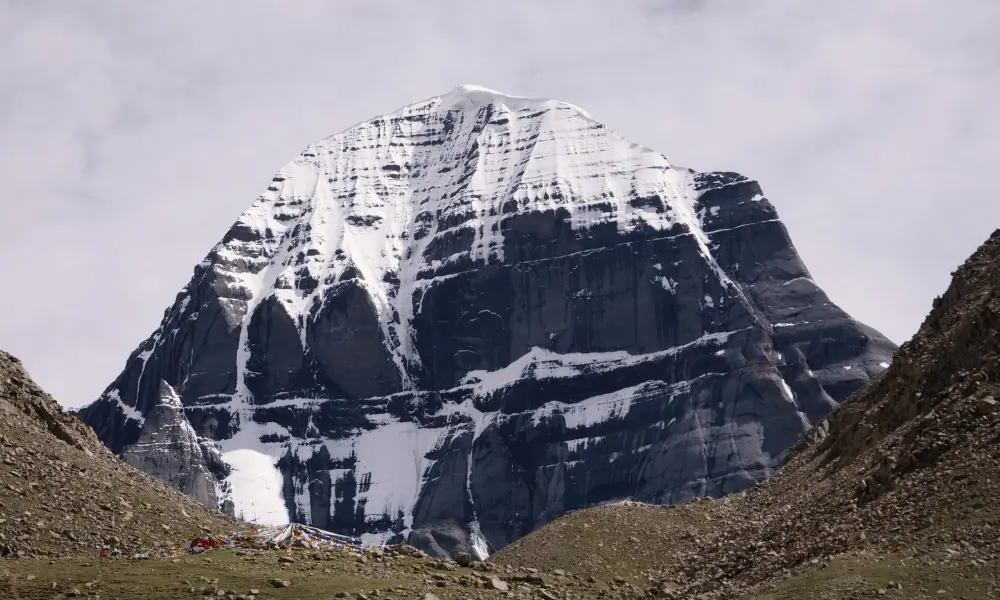
Geologically, granite and gneiss mainly compose Mount Kailash, having been subjected to uplift during the Himalayas formation through tectonic activity. It forms part of the Gangdise range near the sources of some of the continent’s great rivers, such as the Indus, Sutlej, Brahmaputra, and Karnali. Several small glaciers on its slopes empty downstream into these river systems. Thus, the mountain becomes paramount in freshwater generation, hence this revered water tower in the region.
Mount Kailash is a tough landscape with hostile plateaus, rocky terrains, and high-altitude deserts. Near it lie Manasarovar Lake, the highest freshwater lake in the region, and saline Rakshastal Lake, with spiritually contrasting values attached to each. The altitude of the mountain confers unpredictable levels of cold; weather conditions are extreme, making access difficult, thus preserving its untouched and sublime state.
Nearby Major Attractions
Mount Kailash is surrounded by several attractions that enhance the pilgrimage experience and offer rich cultural, historical, and natural insights.
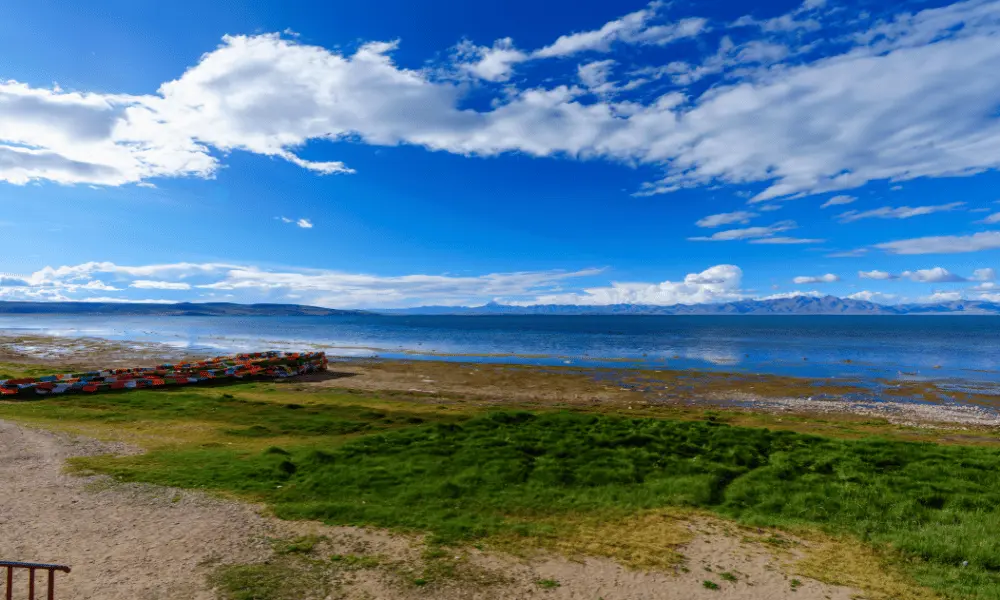
Here are some notable attractions near Mount Kailash:
Lake Mansarovar
Making the area a little more spiritual, Lake Mansarovar is almost next door to Mount Kailash. At an amazing altitude of 4600 m with an area spread of approximately 320 sq.km. which is definitely among the world's highest fresh bodies of water, it has the honor of being situated ever so high above sea level! Mansarovar is highly sacred to a plethora of religions, including Hinduism, Buddhism, Jainism, and Bon. In the Hindu mythology, this lake was conceived in the mind of Lord Brahma. Thus, it is called Manasarovar in Sanskrit, which stands for a combination of manas (mind) and sarovara (lake). Each year, pilgrims who go through the arduous trek up to Mount Kailash stop at Mansarovar, allured by the prospect of dipping themselves in its waters and cleansing their spirits from all sins, thereby earning enlightenment. Mansarovar Lake gives a very serene and tranquil ambience that goes well with the spiritual vibe of Mount Kailash and attracts pilgrims and nature lovers looking for solace and motivation amid spectacular landscapes.
Rakshas Taal
Rakshas Taal is said to be a mysterious beautiful lake close to sacred Mount Kailash. In Hindu mythology, it is said that the demon king, Ravana, built this lake to propitiate Lord Shiva. This saltwater lake, situated at an elevation of close to 4575 metres, presents a very scenic view with the towering Himalayan mountain ranges in its backdrop. Given that the lake literally translates as 'Demon Lake', a certain aura of mystery that springs from local lore and legends surrounds it. And yet, the eerie name does little to intimidate, as one is drawn by the placid waters to the tranquil surroundings, wherein the pilgrims, trekkers, and nature lovers find a serene respite. This eerie lake from the story and the swirl of myth, religion, and nature is a glue that holds together the lore of the sacred region surrounding Mount Kailash.
Yam Dwar
Yam Dwar, called the Gate to the Dead, is the culturally and spiritually important site at an altitude of 5400 meters along the sacred circumambulation of Mount Kailash in Tibet. Tibetans name this place Traboche and witness the festival known as Saga Dawa here. Letting go of worldly attachments for the spiritual journey is what one does while passing through this door. Although the name sounds frightening, the path opens up to magnificent views of the neighboring Himalayan peaks. Set on conspicuously exquisite landscapes, this spiritual gateway presents a retreat for prayer, contemplation, and heavenly grace.
Darchen
Darchen is a small settlement that serves as a base camp for the pilgrims to Mount Kailash. It is the point from where the Parikrama begins and ends, providing various facilities such as accommodation, food, trekking supplies, and permits. The village stands as a place where pilgrims from all over the world gather, including Hindus, Buddhists, Jains, and Bon followers. Despite its small size, Darchen is a very important station for the sacred journey and is mostly where all those interested start readying themselves, mentally and physically, for the rigors of the walk.
Gauri Kunda
At a high altitude smashing the Kailash Kora route, Gauri Kund is considered a very holy lake. It is associated with Goddess Parvati, the consort of Lord Shiva. Hindu mythology states that Goddess Parvati used to bathe in this water. Pilgrims stop here to carry out their ceremonies and believe that taking a dip in the sacred water brings blessings for marital harmony, fertility, and spiritual purity. One has to admit that the mystical tranquility of the lake becomes an unattainable wish from the setting in the pristine Himalayas.
Listen to Our Podcast: Kailash Mansarovar Yatra Attractions
Mount Kailash Myths and Legends
While journeying around Kailash Parvat, one gets to enter worlds replete with stories, myths, and folklore, lending the tall mountain an aura of mystery. This section sets out to explore those stories that portray Kailash, not only as a geographical wonder or a spiritual focus but as a living entity with stories bridging continents and eras. Some of the tales and legends usually told about this cosmic rock are examined below.

There are many other tales and myths surrounding the mountain, labelling it a cosmic mountain with universal significance:
- Axis Mundi: Akin to many other cosmologies, Kailash Parvat is considered the Axis Mundi, the center of the world that joins the Earth with the tinkling of the heavens and murmur of the underworld, a spiritual bridge between the different realms of existence.
- Jain Legends: In Jain mythology, Kailash is called Ashtapada and is believed to be the place where the first Jain Tirthankara, Rishabhdeva, attained moksha. Many Jain scriptures and legends depict the journey of his awakening.
- Buddhist Legends: According to Buddhist legends, Kailash Parvat is Mount Meru, the abode of Buddha Demchok; it is also the site where Milarepa, one of Tibet's great yogis and poets, stopped the sorcerer of Bon civilization from disrupting Tibet and thereby symbolized the triumph of Buddhism over Bon in Tibet.
- Bon Sacred Mountain: For followers of Bon, Kailash Parvat is also a place where the founder of Bon, Tonpa Shenrab, descended from the heavens. The mountain is viewed as a huge mandala of the spiritual world.
- Kailash in the Ramayana: The mountain also finds mention in the epic Ramayana, where it is said to be the abode of the divine birds who are the messengers between gods and humans.
- Unclimbed Status: Mount Kailash, although lower in elevation than the other Himalayan giants, is yet to have been ascended by man. It is said to be the sacred enormity bestowed by the Hindus; all its religions forbid climbing upon it, as it is treated as an act of sacrilege. Most of the reports of those who had tried depict their climbing activities coming to a halt when they were met by huge obstacles.
- Time Dilation & Accelerated Aging: Many pilgrims attest to this time distortion on and around the mountain. Anecdotal evidence suggests an acceleration in biological processes: for example, hair and nail growth at the peculiar rate of weeks in days. Such discussions have led to speculation about some sort of energetic field or magnetic anomalies.
Pilgrimage to Kailash
The pilgrimage to Kailash and Lake Mansarovar goes down as one of the most profoundly spiritual trains of thought around. Across geographical and cultural boundaries, devotees belonging to Hinduism, Buddhism, Jainism, and Bon worship there. Among Hindus, Kailash constitutes the heavenly abode of Lord Shiva and Goddess Parvati, where Shiva spends his eternal meditation and consideration as the axis of the world.

In contrast, various schools of thought assert that Lake Mansarovar was conceptualized by Lord Brahma and is where his Majesty flows, the ocean of purity capable of washing away the sins gathered through countless lifetimes, with one temple bath from its waters. For Buddhists, Kailash is regarded as Mount Meru, their thermonuclear center of existence, where Buddha Demchok and other deities reside, while for the Jains, it is where their very first Tirthankara, Rishabhanatha, attained nirvana. In the Bon tradition, it is also considered a center of power concentrated there, with the founder descending upon that very mountain.
Kailash Mansarovar Yatra
The Kailash Mansarovar Yatra is so much more than a pilgrimage; it is a search for self-realization and spiritual awakening. Let us study some aspects of this divine journey:
Sacred Journey: Referred to as the journey to the "centre of the universe," the Yatra is thus declared the sacred journey promising conjunction of divine energies with spiritual revelations.
Route and Duration: A strenuous walk lasting several days, passing through some of the most scenic and yet challenging terrains is the pilgrimage. Different routes can be taken for reaching Kailash, giving one different views and experiences.
- Kailash Mansarovar Yatra by Drive via Kyirong (10 to 17 days)
- Kailash Mansarovar Yatra by Heli via Simikot (10 to 14 days)
- Kailash Mansarovar Yatra by Flight via Lhasa (10 to 17 days)
Rituals and Customs: Many rituals and customs, such as parikrama or circumambulation of the mountain and a sacred bath into the Mansarovar Lake regarded as soul purification, are part of the Yatra.
- Mount Kailash Parikrama
- Puja at the shore of Lake Mansarovar
Spiritual Significance: The pilgrimage holds huge spiritual importance among the religions of Hinduism, Buddhism, Jainism and Bon followers. It is believed that the Yatra could remove one's sins of a lifetime and pave the way for salvation.
Learn More: What is Kailash Mansarovar Yatra?
Kailash Mansarovar Yatra Packages
Kailash Yatra has been providing Kailash Pilgrims with expertly prepared tour packages for years. We provide everything from luxurious helicopter flights to individual tours and group joining packages to Kailash. Here are some of the popular Kailash Yatra tour packages we offer:

Kailash Mansarovar Yatra by Drive via Kyirong
On an overland route through Nepal and Tibet where vistas of splendid scenery abound, this is a wonderful choice for those who want to travel by road and slowly adjust to the altitude.
Outline Itinerary:
|
DAY 01: Kathmandu Arrival. |
|
DAY 02: Kathmandu Sightseeing, Visa Application. |
|
DAY 03: Bhaktapur Sightseeing. |
|
DAY 04: Chandragiri Sightseeing. |
|
DAY 05: Packing and Final Preparation. |
|
DAY 06: Drive from Kathmandu to Dhunche or Syabrubesi or Timure. |
|
DAY 07: Drive to Kyirong. (2850 m) |
|
DAY 08: Drive to Saga. (4500 m) |
|
DAY 09: Drive from Saga to Lake Mansarovar. (4650 m) |
|
DAY 10: Drive to Darchen. (4700 m) |
|
DAY 11: Drive to Yama Dwara Trek to Deruphuk. (4050 m) |
|
DAY 12: Trek to Zuthulphuk. (4800 m) |
|
DAY 13: Zuthulphuk to Saga. (4500 m) |
|
DAY 14: Drive back to Kyirong. (2850 m) |
|
DAY 15: Drive to Kathmandu. (1400 m) |
|
DAY 16: Transfer to Airport. |
Learn More: Kailash Mansarovar Yatra by Drive via Kyirong
Kailash Mansarovar Yatra by Heli
Suitable for those with limited time, this package facilitates a fast and comfortable way of reaching. It provides plenty of splendid views from the air and spares one from long drives.
Outline Itinerary:
|
DAY 01: Kathmandu Arrival. (1400 m) |
|
DAY 02: Kathmandu Sightseeing. |
|
DAY 03: Bhaktapur Sightseeing. |
|
DAY 04: Chandragiri Sightseeing. |
|
DAY 05: Pack and Fly to Nepalgunj. |
|
DAY 06: Fly from Nepalgunj to Simikot. (2910 m) |
|
DAY 07: Simikot - Hilsa - Taklakot. (4025 m) |
|
DAY 08: At Taklakot – Rest Day Full Day – Free for Acclimatisation. |
|
DAY 09: Drive from Taklakot to Lake Mansarovar. (4650 m) |
|
DAY 10: Drive to Yama Dwara, Trek to Deruphuk. (4050 m) |
|
DAY 11: Trek to Zuthulphuk. (4800m) |
|
DAY 12: Zutulphuk to Hilsa or Simikot. |
|
DAY 13: Hilsa to Simikot, Fly back to Kathmandu via Nepalgunj. |
|
DAY 14: Transfer to Airport. |
Learn More: Kailash Mansarovar Yatra by Heli
Kailash Mansarovar Yatra Private Tour
Our private tours are completely flexible. Whether you are traveling alone, with family, or in a small group, we create the experience around your schedule and wishes.
Outline Itinerary:
|
DAY 01: Kathmandu Arrival. |
|
DAY 02: Kathmandu Sightseeing, Visa Application. |
|
DAY 03: Bhaktapur Sightseeing, Nagarkot Stay. |
|
DAY 04: Chandragiri Sightseeing. |
|
DAY 05: Packing and Final Preparation. |
|
DAY 06: Drive to Dhunche or Syabrubesi or Timure. |
|
DAY 07: Drive to Kyirong. (2850 m) |
|
DAY 08: Drive to Saga. (4500 m) |
|
DAY 09: Drive from Saga to Lake Mansarovar. (4650 m) |
|
DAY 10: Drive to Darchen. (4700 m) |
|
DAY 11: Drive to Yama Dwara, Trek to Deruphuk. (5050 m) |
|
DAY 12: Trek to Zuthulphuk. (4800 m) |
|
DAY 13: Zuthulphuk to Saga. (4500 m) |
|
DAY 14: Drive back to Kyirong. (2850 m) |
|
DAY 15: Drive to Kathmandu. (1400 m) |
|
DAY 16: Transfer to Airport. |
Learn More: Kailash Mansarovar Yatra Private Tour
We will coordinate the logistics: permits, accommodation, meals, and safety. At least free your mind from the details for a time as you focus on your spiritual experience. Begin your sacred journey with us.
Yatra Essentials
The Kailash Mansarovar Yatra is more than just a journey; it is a spiritual pilgrimage that appeals to the soul. But truth be told, going through the high altitudes and rough terrains of the Himalayas is something that takes some serious preparation! The required items are not simply about comfort but also safety and making sure you will be able to derive the full value from the once-in-a-lifetime experience. From wild changes in the weather to the altitude, everything you carry in your bag has significance.

Let's get down and list what are the essentials for your Kailash Mansarovar Yatra to be memorable for all the right reasons.
Important Documents
Think of these as your golden tickets for the roof of the world. Without them, your journey ends before it even begins!
- Passport & Chinese Group Visa: Double-check their validity! Your passport needs to be good for at least six months beyond your trip date. Your tour operator usually applies for the Chinese group visa for Tibet, but confirm all this well in advance.
- Tibet Travel Permit: This is your entry pass into Tibet and is normally handled by your tour operator. Keep it handy.
- Travel Insurance: Must be there! You must have comprehensive coverage that includes medical emergencies and high-altitude evacuation. This is nothing less than a recommendation; this is your lifeline.
- Flight Ticket Copies: You should always carry copies of your flight details, but most importantly, photocopy all your documents (passport, visa, permits, insurance). Store them away from the place where you keep the original copies, and if possible, laminate them to protect from moisture.
- Cash & Cards: You'll want Nepalese Rupees (NPR) while in Kathmandu and Chinese Yuan (CNY) for Tibet expenses. Cards work only in the larger towns; cash is king when it comes to remote areas.
Packing
Kailash Mansarovar's weather is notoriously changeable; one moment the sun shines, the next snow falls. The secret? Layers, layers, layers.
- Base Layers (moisture-wicking): Thermal underwear (2-3 sets) and quick-dry long-sleeved shirts are the base layers. Merino wool or synthetics work best to keep you dry and warm.
- Mid Layers (for warmth): A fleece jacket or light down vest will provide insulation along with woolen sweaters.
- Outer Layers (The shields): A waterproof, windproof jacket is a must-have. This will serve as your main defence against rain, snow, and the biting wind. Waterproof trekking pants which are comfortable and durable. Zip-off legs can be very handy. A heavy-duty down jacket for extreme cold during Kailash Parikrama (circumambulation).
Footwear
- Hikers with ankle support: They ought to be waterproof, cushioned well, and possess a good grip. Do break them in well before you go! Blisters aren't fun at 15,000 feet above sea level.
- Thermal socks: About 5-6 pairs of water-wicking ones.
- Camp slippers/sandals: For soothing tired feet by evening.
Head & Hand Gear
- Warm hat/beanie: Keep those ears covered (carry two!).
- Wide-brimmed sun hat: Great for intense UV protection in the daytime.
- Gloves: One waterproof and insulated pair and one pair of liners for added warmth.
- Buff or scarf: Helps with shielding your face from dust, cold, and sun.
- Face Mask: Protects against dust and dry air.
- Raincoat: An oversized one is great for covering you and your daypack.
Health and Medical
That is one place where no compromises can be made. The altitude plays a heavy role, and the preparedness is above all else.
- First Aid Kit: Carry a complete one with bandages, antiseptic, blister pads, pain relievers like Paracetamol or Ibuprofen, antacids, anti-diarrheal, muscle relaxants, eye drops, and any general antibiotics after consulting your doctor, of course. Do not forget ORS (Oral Rehydration Salts) sachets!
- Acclimatization (Diamox): You should talk to your doctor about it before you leave. Begin taking this medication if it is prescribed to you, as instructed.
- Portable Oxygen Can: Take it along- very useful during the Parikrama.
Keep Hydrated
- Insulated Water Bottle (1L+): Hydration is your number one protection against altitude sickness.
- Thermos Bottle: For warm water or tea, it is a real treat at all freezing cold.
- Water Purification Tablets/Filter: Should you choose to refill from natural water sources.
- High SPF sunscreen (SPF 50+): Slather it on!
- Lip Balm with SPF: To combat terrible chapped lips.
- UV Protective Sunglasses (100% UV Protection, polarized): Snow blindness will be your least worry.
- For Hygiene: Toilet paper (in Ziploc bags!), wet wipes, hand sanitizer, biodegradable soap, toothbrush, toothpaste, moisturizer and microfiber towel that dries fast.
- Personal Medications: Ensure you have a sufficient supply of any prescription medications you take regularly.
Learn More: Kailash Mansarovar Yatra Packing List
Best Time to Visit Kailash
Generally, making the trek for the Yatra on Mount Kailash can be done from May to September. These months seem to provide the most favorable weather conditions for trekking and traveling in this high-altitude area.

Spring (May - June): Highly Recommended
Pros: It is considered one of the best times. The weather remains somewhat mild with comfortable daytime temperatures (5°C to 20°C). Snow begins to melt, so trekking paths become better and more secure along with improved conditions. The sky remains mostly clear, providing magnificent views of Mount Kailash and Lake Mansarovar. Few travelers around at this time set a peaceful state. The auspicious Saga Dawa festival (commemorating Buddha's birth, enlightenment, and death) usually happens during May or June, attracting many pilgrims.
Cons: The nights may still be cold. Early May may sometimes come with chills and a smidge of snow.
Summer/Monsoon (July - August): Endurable with some considerations
Pros: Temperatures in this period are mostly (around 10°C to 23°C during the day). Its landscape is lush, especially from the downhill regions of Nepal. Although it is monsoon time, Nepal itself, being in cloudburst mode, competes with Tibet receiving heavy rainfall. But Tibet is generally very dry and comparatively receives less of a bout of rain than Nepal and hence heavy incessant raining is a rarity. There are many pilgrims who travel during this period because of other religious festivals like the holy Shravana month.
Cons: The biggest challenge is monsoon rains, particularly in the Nepal border region, leading to slippery roads and possibilities of landslides and sudden delays in travel. Humidity soaring!
Autumn (September): Strongly Recommended
Pros: This is also a wonderful time to travel. The closing phase of the monsoons assures clear skies and settled weather. Temperature is comfortable: it stays around five degrees Celsius to fifteen degrees Celsius during the daytime and the air remains quite crisp. The landscape remains green, an excellent sight for photographers. There is a calming crowd, less than in the peak summer months.
Cons: Days become shorter as nights grow colder. This goes till the very thin window before the dreaded winter sets in.
Winter (November - April): Not Recommended
This is the worst time to visit. Temperatures go down to unforgiving lows (normally below minus 20 degrees Celsius at night), roads get snowed out, and winds blow like crazy. Most of the guesthouses and amenities close down, and also, the high-altitude terrain becomes an extreme danger due to snow and ice, especially across Dolma La Pass. Moreover, the region officially remains closed during these months.
Learn More: Best time to Visit Kailash Mansarovar
Kailash Yatra Travel Tips
This sacred pilgrimage, lying deep in the vast mayhem of the Tibetan Himalayas, demands thorough preparation, physically, mentally, and from a logistical standpoint. Are you yearning for God's presence, nature's beauty, or a wandering soul? An informed traveler will glide with ease and absolute fulfillment.

Check out the must-know tips for navigating your one-in-a-lifetime yatra with confidence and a pinch of reverence.
- Getting Fit: No slow walk around here. Start intense cardiovascular exercises-walking, jogging, stairs-2-3 months before. Prepare your thighs and stomach muscles. Give your doctor a full check-up, and discuss with him the idea of taking altitude sickness medication like Diamox.
- Acclimatization is Key: Take it slow! The itinerary must permit a gradual rise in altitude and rest days thereafter. Hydrate yourself, drinking up to 3-4 liters of water. Listen to your body-every AMS sign matters. If symptoms hit-headache or even nausea-tell your guide and do not hesitate to go down.
- Pack Smart: The weather switches fast. Think moisture-wicking thermals topped with a fleece and then a down jacket that is waterproof and windproof. Back up all of your weather protection with sturdy, broken-in trekking boots. Don't forget a warm hat and gloves, high SPF, lip balm, and glareproof sunglasses.
- Documents: Your passport needs to be valid for a minimum of six months. Your reputable tour operator will procure the complex Chinese Group Visa and Tibet Travel Permit for you-you cannot do so yourself. Photocopy everything, then scan the copies and back them up digitally.
- Mindset: Things may go wrong (weather, delays). Stay flexible and patient. Dress modestly, learn a few basic Tibetan phrases to get by, and embrace the simple facilities.
Also Read: Kailash Mansarovar Yatra Preparation
Conclusion
Mount Kailash is basically an everlasting myth in the Himalayas, a reality having a geological basis, which has come to stand as the ultimate symbol for spiritual euphoria and natural magnificence, offering avenues for pilgrimage and adventure. Its peculiar pyramidal shape, coupled with the mystical ambience created by the lakes Mansarovar and Rakshas Tal, forms a fertile basis for centuries of legends, a very short-class representation for divine abodes and the very life-giving Asian rivers. Hence, the difficult journey to this mountain signifies not only a hard physical trek but, more importantly, a spiritual odyssey for many, moving them beyond the very self-there is ecology in the region to be safeguarded through the conservation of this serene, immemorial landscape for future generations.
Frequently Asked Questions (FAQs)
Here are some FAQs related to Mount Kailash:
Why is Mount Kailash considered sacred?
Mount Kailash is considered significant majorly in 4 religions: Hinduism, Buddhism, Jainism and Bon. In Hinduism, Lord Shiva is believed to reside here. From the Buddhist point of view, they consider it the legendary Mount Meru. Jains consider Mount Kailash to be the site of liberation of their first Tirthankara, while the Bonpo see it as a seat of spiritual power.
Can one climb Mount Kailash?
No. Climbing Mount Kailash is forbidden as a sign of respect for its religious significance. No official, credible record has been made of anyone climbing Mount Kailash.
How long does the Kailash Parikrama last?
Depending on one's health, acclimatization altitude, and the weather, it traditionally takes about 3 days.
Can a helicopter fly over Mount Kailash?
No, a helicopter cannot fly over Mount Kailash. However, one can choose to travel by helicopter from the Simikot route for the Kailash Yatra, where the helicopter ride is from Simikot to Hilsa, which is the Nepal-Tiber border.

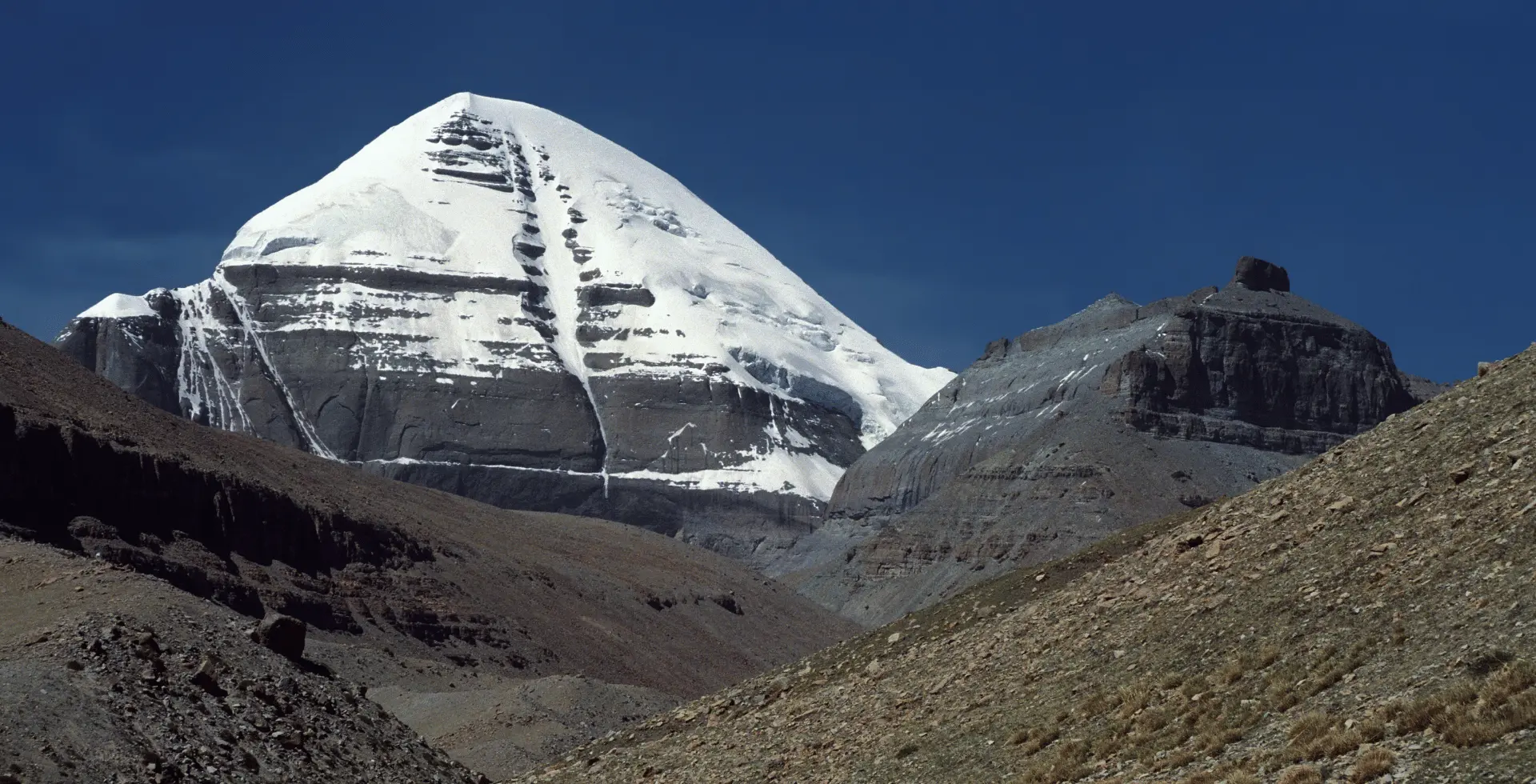
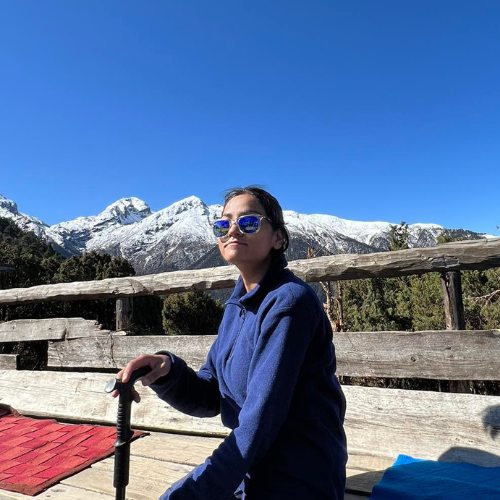 Mandira Itani
Mandira Itani